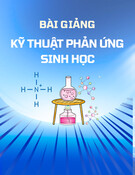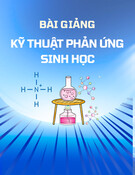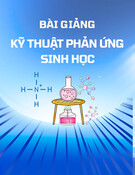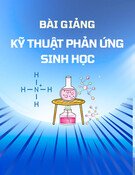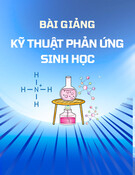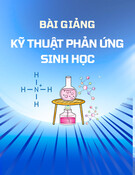
JOURNAL OF SCIENCE AND TECHNOLOGY DONG NAI TECHNOLOGY UNIVERSITY
204
Special Issue
CONTROLLABLE SYNTHESIS OF N-ARYLHYDROXYLAMINES
FROM NITROARENES BY HIGHLY CHEMO-SELECTIVE TWO-
STEP TANDEM REDUCTION USING A NOVEL BACTERIAL
NITROREDUCTASE
Hieu-Huy Nguyen-Tran1,2*, Thi-Ngoc Nguyen1,2, Gao-Wei Zheng3 and Jian-He Xu3
1 China Medical University-Taiwan
2Dong Nai Technology University
3East China University of Science and Technology
*Corresponding author: Hieu-Huy Nguyen-Tran, nguyentranhieuhuy@mail.cmu.edu.tw
GENERAL INFORMATION
ABSTRACT
Received date: 01/04/2024
N-Arylhydroxylamines serve as versatile intermediate organic
molecules for the synthesis of industrially valuable fine
chemicals, bioactive drugs, and polymerization inhibitors.
Due to the active electron group of -NHOH in
arylhydroxylamines, it is an extremely unstable and easily
further reduced to corresponding amines. In addition, the
synthesis of arylhydroxylamines by conventional chemical is
usually performed using toxic heavy metals and chemical
additives under high pressure and high temperature
conditions. Thus, a novel eco-method is urgently needed. In
this study, we developed a continuous flow method to
synthesize arylhydroxylamines by a novel nitroreductase from
Geodermatophilus obscurus, which shows high activity and
chemo-selectivity in converting nitroarenes to N-
Arylhydroxylamines (>99%) under mild condition. This
method therefore provides a novel avenue to synthesis N-
hydroxylamine.
Revised date: 22/05/2024
Accepted date: 18/07/2024
KEYWORD
Biosynthesis
Nitroreductase
N-arylhydroxylamines
Green chemistry
1. INTRODUCTION
N-Arylhydroxylamines are an important class
of compounds frequently used as key precursors for
the synthesis of fine chemicals (Ahmad & Hughes,
2002; Ho & Lau, 2000; Lamar & Nicholas, 2009;
Rios et al., 2006; Spence et al., 2003; Sridharan et
al., 2006; Wang et al., 2011) and biologically active
substances (Johansson et al., 2003; R. J. Knox,
1991; Smith et al., 1999; Svensson, 2003; Vyas et
al., 2005). Therefore, the synthesis of
arylhydroxylamines has been an attractive topic for
synthetic chemists. Several methods have been
developed for the preparation of
arylhydroxylamines, including stoichiometric
reduction (using zinc, tin or sulfide) (Bartra et al.,
1990; Gassman & Grandrud, 1984; Haworth &
Lapworth, 1925; Kamm, 1941; Liu et al., 2009;
Marvel & Kamm, 1919), electrochemical reduction
(H. A. Cyr, 1989; Seshadri & Kelber, 1999),
catalytic hydrogen transfer (Beaudoin & Wuest,
2011; Davis, 1988; K.Taya, 1966; Takenaka, 2008;
Takenaka et al., 2010; Takenaka et al., 2011) and
selective catalytic hydrogenation of nitro
compounds (Ayyangar et al., 1984; Entwistle et al.,
1978; Karwa & Rajadhyaksha, 1987; Rondestvedt

205
JOURNAL OF SCIENCE AND TECHNOLOGY DONG NAI TECHNOLOGY UNIVERSITY
Special Issue
et al., 1977). However, arylhydroxylamines, as
intermediates formed during the reduction of
nitroaromatics, are frequently further reduced to
amines, meanwhile some side-reaction products
such as azoxy-, azo-, and hydrazo compounds are
often formed simultaneously (Corma et al., 2007;
Makosch et al., 2012). Thus, it is challenging to
obtain arylhydroxylamines in high chemo-
selectivity by these chemical catalytic routes.
Recently, efforts have focused on the direct
synthesis of arylhydroxylamines through selective
catalytic hydrogenation of nitroarenes. (Rong et al.,
2010; Takenaka et al., 2009) However, these
processes are not environmentally benign due to
using of toxic heavy metals and chemical additives.
Therefore, the development of more efficient and
greener methods for highly chemoselective
production of arylhydroxylamines remains highly
desirable. The selective bioreduction of nitro
compounds may an ideal choice to produce
arylhydroxylamines because biocatalysts inherently
exhibit high chemoselectivity, and the reduction
frequently occurs under mild reaction conditions
with theoretical yield of 100%, making processes
are environmentally benign (Bornscheuer et al.,
2012). Early biocatalytic methods used baker’s
yeast (Li et al., 2004) and grape cells (Li et al., 2005)
for preparing arylhydroxylamines. In the baker’s
yeast system, the amount of biocatalyst and reaction
time must be precisely controlled; otherwise the
formed hydroxylamines would be further converted
to amines. In the grape cell system, due to the poor
activity of the plant cells, the reduction has the
shortcoming of low efficiency with long reaction
time, using a large quantity of biocatalyst and low
concentration of substrate.
Nitroreductase (NTR) is a famlily of reduction
enzyme that could reduce the nitro-group in the
nitroaromatic compounds through a ping-pong bi-bi
kinetic mechanism (Roldan et al., 2008). NTR could
be futher devided into two subclass: oxygen-
insensitive (type 1) and oxygen-sensitive (type 2).
Type 1 NTR could be further divided into major and
minor protein groups. The major group could utilise
both nicotinamide adenine dinucleotide (NAPH) or
nicotinamide adenine dinucleotide phosphate
(NADPH) as the electron donor while minor group
can only utilise NADPH as the electron donor
(Hollmann et al., 2011; Nyanhongo et al., 2005;
Roldan et al., 2008; Symons & Bruce, 2006). The
reduction of nitro-group by nitroreductase is a
dynamic process in which many intermediates
compounds could be produced, including nitroso,
hydroxylamine and amine under mild condition
(Thomas & Gwenin, 2021). Recently, many
researcher groups tried to used NTR from bacteria
to degrade nitroaromatic compounds, and could
detect the N-Arylhydroxylamines in the mixture of
reaction (Cenas et al., 2021). These findings imply
the possibility of obstaining N- Arylhydroxylamines
from nitroaromatic compounds by NTRs. In this
report, by using bioinformatic tools, we identified
NTR from Geodermatophilus obscurus exhibits
oustanding reduction activity and chemo-selectivity
for N-Arylhydroxylamines synthesis.
2. MATERIALS AND METHODS
Screening for potential NTRs
Two nitroreductases sequence from
Bacillus licheniformis DSM 13 (yfkO and
NfrA; SwissProt, Q65MG6 and Q65DM9,
respectively) was inputted into the Basic Local
Alignment Search Tool (BLAST) of National
Center for Biotechnology Information (NCBI)
as a probe. Candidate NTRs was selected
between 75%-50% similarity citeria on the
result of the pBLAST searching with these two
probes.
Chemical and reagent
All nitroarenes were purchased from Aladdin
Chemicals Co. Ltd. (Shanghai, China) with >97%
purity. T4 DNA Ligase, Restriction endonuclease
BamH I, EcoR I, Xho I, Nde I and Hind III were
purchased from Takara Bio USA, Inc.

JOURNAL OF SCIENCE AND TECHNOLOGY DONG NAI TECHNOLOGY UNIVERSITY
206
Special Issue
NTRs activity definition
Nitroreductase activity was determined in 1
ml final volume of 100 mM sodium phosphate
buffer (pH 7.0) containing 1 mM nitroarene and
0.1 mM NADPH. One unit of the enzyme
activity (IU) was defined as the amount of
enzyme required to oxidize 1 μmol NADPH per
minute at 30°C and pH 7.0, and was measured
by following the initial and linear decrease in
absorbance at 340 nm (Kim & Song, 2005).
Protein purification
The recombinant nitroreductase with an N-
terminal His-tag was rapidly purified to
electrophoretic homogeneity by nickel affinity
chromatography (Hochuli et al., 1988; Sun et
al., 2023). The samples of cell-free extract and
purified target protein were analyzed by SDS-
PAGE.
Production detection
The conversion of substrates,
chemoselectivity and yield of products were
determined by HPLC (Shimazu, China)
equipped with a reverse-phase C18 column
(Inerstill ODS-4, Ф 4.6 mm × 250 mm × 5 µm).
The samples were eluated by a mobile phase of
methanol-water-citric acid: 60/40/1 (v/v/g) in
flow rate of 0.8 ml/min and monitored at 254
nm with an UV detector. 1H NMR and 13C
NMR were measured on a Bruker Avance 400
MHz and 500 MHz spectrometer with chemical
shifts reported as ppm (TMS as internal
standard) (Willoughby et al., 2014; Zhang et al.,
2016).
3. RESUTLS
NTR from Geodermatophilus obscurus
exhibit highest nitrorecutase activity
In the attempt finding novel enzyme that
could be used in N-Arylhydroxylamines
synthesis, we first used BLAST function of
NCBI with two published NTRs coding-
sequence as a probe. Nine candidate NTRs were
selected which show the similarity with probe
sequence between 75%-50% (Table 1).
Table 1. List of primers used in this study for amplifying coding-sequence of potential NTRs.

207
JOURNAL OF SCIENCE AND TECHNOLOGY DONG NAI TECHNOLOGY UNIVERSITY
Special Issue
These coding sequences were then inserted
into pET-28a (+) plasmid. Constructed
plasmids were then transformed into E. coli
BL21 for heterogeneous expression. We used
4-cyanonitrobenzene as substrate for
investigating NTR activity. E. coli cells that
express NTRs were homogenized by sonication
for releasing intracellular contexts. The liquid
was then centrifuged to remove cell debris. The
supernatant was used for enzyme activity
measuring. As shown in Figure 1, NTR from
Geodermatophilus obscurus (GoNTR) shows
the highest nitroreductase activity. Note that
the measuring was performed under mild
conditions implying the possibility for
synthesis N-hydroxylamine by biocatalytic.
Figure 1. The activity of candidate NTRs toward
4-cyanonitrobenzene. The NTRs from
Geodermatophilus obscurus (GoNTR) exhibited
the highest nitroreductase activity (labelled by red
arrow).
GoNTR shows high chemo-selectivity to N-
arylhydroxylamine
Figure 2. GoNTR exhibits high chemo-
selectivity to arylhydroxylamine. (A) High-
performance liquid chromatography (HPLC) of
the end-point reaction mixture shows a unique
peak of product (blue arrow). The substrate
(nitro aromatic compound) in reaction mixture
is below detectable level (black arrow). (B) 1H
NMR spectra and (C) 13C NMR spectra of N-
(4-cyanophenyl)-hydroxylamine.
As mentioned above, the reduction of
nitroaromatic compounds could produce nitroso,
hydroxylamine, and amine. The chemo-
selectivity of N-hydroxylamine is defined as the
percentage of N-hydroxylamine per nitroso and
amine. To test the chemo-selectivity of N-
hydroxylamine, we extracted the reaction
mixture, detected, and quantified the
concentration of N-hydroxylamine. As shown in
Figure 2A, GoNTR shows excellent chemo-
selectivity (N-(4-
cyanophenyl)hydroxylamine≥99%). We did not
detect the existence of 4-cyanophenyl amine in
the reaction mixture. The production of reaction

JOURNAL OF SCIENCE AND TECHNOLOGY DONG NAI TECHNOLOGY UNIVERSITY
208
Special Issue
was further performed Nuclear Magnetic
Resonance (NMR) of 1H and 13C determining the
content and purity of a sample as well as its
molecular structure (Figure 2B&C).
The characteristic of GoNTR
For precisely investigating the characteristic
of GoNTR, we purified GoNTR by immobilized
metal ion affinity chromatography (IMAC). The
supernatant mixture before and after purification
of GoNTR shows in Figure 3A. We used purified
protein to investigate the characteristics of
GoNTR, including the effect of pH and
temperature on its activity.
Figure 3. The characteristic of GoNTR. (A) SDS-
PAGE analysis of the purified GoNTR protein.
Lane M: protein markers; Lane 1: cell-free extract;
Lane 2: purified protein. (B) Effects of temperature
on activity of the purified nitroreductase GoNTR.
(C) Effects of temperature on activity of the
purified nitroreductase GoNTR. (D)
Thermostability of the purified nitroreductase
GoNTR in different temperatures.
As shown in Figure 3B, the activity of
GoNTR gradually increases with pH value and
reaches its peak at pH =7.0 in potassium
phosphate buffers (KBP) buffer. We also note
that KBP buffer exhibits higher activity than
citrate acid in the same pH value (Figure 4B,
pH=5.0 and pH =6.0). GoNTR shows highest
activity around 35°C and 40°C (Figure 3C). In
large-scale biosynthesis, the thermostability of
enzyme is one of the most important parameters.
GoNTR shows excellent thermo-resistance. The
activity of GoNTR still remains around 50% after
48h at 40°C condition. The activity of GoNTR
rapidly reduces to 25% after 6h and loses it
activity after 12h at 60°C condition (Figure 3D).
Taken all together, the optimal reaction condition
of GoNTR is in pH=7.0 KBP buffer at 35°C.
Synthesis N-arylhydroxylamine by GoNTR
NTRs is a reduction enzyme which used
NADPH as the electron donor and produce
NADP+ (Ferri et al., 2011). Glucose
dehydrogenase (GDH) is an oxidoreductase that
participates in glucose metabolism. GDH
catalyzes the oxidation of glucose in the presence
of cofactors like NADP+ to produce NADPH.
Therefore, GDH is a general tool for driving
nicotinamide (NADPH) regeneration in synthetic
biochemistry (Qian et al., 2020). To establish a
continuous flow bioreaction, we coexpressed
GoNTR and BmGDH in E. coli BL21 for cell
self-regeneration of the coenzyme (Figure 4A).
We applied the coexpressed system with the
optimal reaction condition, shown in Figure 3, to
synthesis 4-
(Cyanomethanyl)phenyl)hydroxylamine from 4-
cyanonitrobenzene.
Figure 4. The continuous flow bioreaction of N-
arylhydroxylamine. (A) The schematic shows how
the system works. (B) Real-time conversion
percentages of aromatic nitro, N-
arylahydroxylamines, and arylamines.


![Tổng hợp cấu trúc lai giáp cạnh 5H-thiazolo[2′,3′:2,3]imidazo[4,5-b]indole bằng phản ứng ghép cặp C-N liên tiếp xúc tác đồng](https://cdn.tailieu.vn/images/document/thumbnail/2025/20250330/vimitsuki/135x160/2451743340007.jpg)


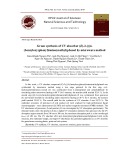
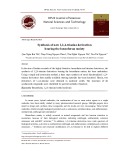
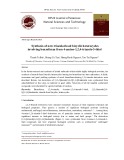
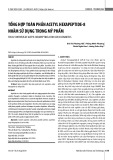

![Nghiên cứu tổng hợp dẫn xuất thế thieno[3,2-b]thiophen bằng phản ứng xúc tác palađi](https://cdn.tailieu.vn/images/document/thumbnail/2024/20240929/xuanphongdacy09/135x160/8461727545047.jpg)



![Bài tập Đa dạng thế giới sống [kèm đáp án/ hướng dẫn giải]](https://cdn.tailieu.vn/images/document/thumbnail/2025/20251123/thaohoang9203@gmail.com/135x160/5861763951302.jpg)
